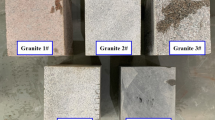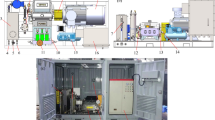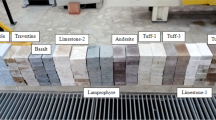Abstract
Abrasive waterjets are widely used in the fields of civil and mechanical engineering for cutting a great variety of hard materials including rocks, metals, and other materials. Cutting depth is an important index to estimate operating time and cost, but it is very difficult to predict because there are a number of influential variables (e.g., energy, geometry, material, and nozzle system parameters). In this study, the cutting depth is correlated to the maximum kinetic energy expressed in terms of energy (i.e., water pressure, water flow rate, abrasive feed rate, and traverse speed), geometry (i.e., standoff distance), material (i.e., α and β), and nozzle system parameters (i.e., nozzle size, shape, and jet diffusion level). The maximum kinetic energy cutting depth model is verified with experimental test data that are obtained using one type of hard granite specimen for various parameters. The results show a unique curve for a specific rock type in a power function between cutting depth and maximum kinetic energy. The cutting depth model developed here can be very useful for estimating the process time when cutting rock using an abrasive waterjet.










Similar content being viewed by others
Abbreviations
- C c :
-
Coefficient of curvature in grain size distribution curve (–)
- C e :
-
Mixing efficiency coefficient in inelastic collision theory (–)
- C k :
-
Coefficient in the relationship between water velocity and water pressure [\({{{\text{m}}^{2} } \mathord{\left/ {\vphantom {{{\text{m}}^{2} } {\left( {{\text{s}}\, \cdot \sqrt {\text{kg}} } \right)}}} \right. \kern-0pt} {\left( {{\text{s}}\, \cdot \sqrt {\text{kg}} } \right)}}\)]
- C p :
-
Coefficient in the relationship between maximum kinetic energy and mass flow rate (m2/s)
- C u :
-
Coefficient of uniformity in grain size distribution curve (–)
- D :
-
Cutting depth formed at the center of jet energy distribution (mm)
- E :
-
Kinetic energy (J)
- E et :
-
Effective kinetic energy (J)
- E max :
-
Maximum energy in effective kinetic energy distribution (J)
- E p :
-
Energy at a point generated in the pump section (J)
- E t :
-
Energy at a point generated in the pipe tip section (J)
- E u :
-
Unit energy in effective kinetic energy distribution (J)
- ER:
-
Effective jet radius from the center of target area on the material surface (cm)
- K :
-
Flow resistance constant (energy loss coefficient due to an enlargement or contraction of the water flow section) (–)
- Q :
-
Water flow rate (ml/s)
- Z a :
-
Transformed random variable on cumulative distribution function (–)
- d 50 :
-
Mean particle diameter (mm)
- d n :
-
Focusing tube diameter (cm)
- d o :
-
Orifice nozzle diameter (mm)
- d s :
-
Standoff distance between the nozzle tip and the target material surface (cm)
- d s(critical) :
-
Critical standoff distance (cm)
- g :
-
Acceleration due to gravity (m/s2)
- \(\dot{m}_{\text{a}}\) :
-
Abrasive mass per unit time (kg/s)
- \(\dot{m}_{\text{g}}\) :
-
Gas mass per unit time (kg/s)
- \(\dot{m}_{\text{w}}\) :
-
Water mass per unit time (kg/s)
- o :
-
Center of target area on the material surface (–)
- p wp :
-
Water pressure in the pump section (kg/m2)
- p wt :
-
Water pressure in the pipe tip section (kg/m2)
- r :
-
Distance from the center of target area on the material surface (cm)
- s n :
-
Traverse speed of nozzle (mm/s)
- t :
-
Jet exposure time at a point on the target surface (s)
- tanθ :
-
Jet diffuse level (–)
- v a :
-
Abrasive velocity (m/s)
- v g :
-
Gas velocity (m/s)
- v s :
-
Jet slurry velocity of the water-abrasive mixture (m/s)
- v w :
-
Water velocity (m/s)
- v wp :
-
Water velocity in the pump section (m/s)
- v wt :
-
Water velocity in the pipe tip section (m/s)
- w :
-
Water weight of the element (kg·m/s2)
- z wp :
-
Elevation of the point above a reference plane in the pump section (m)
- z wt :
-
Elevation of the point above a reference plane in the pipe tip section (m)
- α :
-
Constant in the relationship between cutting depth and maximum energy [cutting depth (mm) at kinetic energy of 1 J] (mm)
- β :
-
Exponent in the relationship between cutting depth and maximum energy (–)
- γ :
-
Unit weight of water (kg/m3)
- μ :
-
Mean value of cumulative distribution function (cm)
- σ :
-
Standard deviation of waterjet kinetic energy in a normal distribution (cm)
References
Agus M, Bortolussi A, Careddu N, Ciccu R, Grosso B (2000) Optimization of abrasive-workpiece matching. In: BHR group conference series publication, vol 41. Professional Engineering Publishing, Bury St. Edmunds, pp 171–182
Aydin G, Karakurt I, Aydiner K (2013) Prediction of the cut depth of granitic rocks machined by abrasive waterjet (AWJ). Rock Mech Rock Eng 46:1223–1235
Chen FL, Siores E (2001) The effect of cutting jet variation on surface striation formation in abrasive water jet cutting. Int J Mach Tools Manuf 41:1479–1486
Cho GC, Oh TM (2011) Excavation system using a water jet, and excavation method using the same, US patent application 13/876,782
El-Domiaty AA, Abdel-Rahman AA (1997) Fracture mechanics-based model of abrasive waterjet cutting for brittle materials. Int J Adv Manuf Technol 13:172–181
Engin IC, Bayram F, Yasitli NE (2013) Experimental and statistical evaluation of cutting methods in relation to specific energy and rock properties. Rock Mech Rock Eng 16:755–766
Finnie I (1960) Erosion of surfaces by solid particles. Wear 3:87–103
Harris HD, Hellor Malcolm (1974) Cutting rock with water jets. Int J Rock Mech Min Sci Geomech Abstr 11:343–358
Hashish M (1988) Visualization of the abrasive waterjet cutting processes. Exp Mech 28(2):159–169
Henning A, Westkämper E (2003) Modelling of wear mechanisms at the abrasive waterjet cutting front, paper 3-A. In: Proceeding of the 2003 American water jet conference, Texas
Hood M, Nordlund R, Thimons E (1990) A study of rock erosion using high-pressure water jets. Int J Rock Mech Min Sci Geomech Abstr 27(2):77–86
Karakurt I, Aydin G, Aydiner K (2012) An experimental study on the depth of cut of granite in abrasive waterjet cutting. Mater Manuf Proc 27:538–544
Kolahan F, Khajavi H (2011) Modeling and optimization of abrasive water jet machining parameters using regression analysis. Int J Aerosp Mech Eng 5(4):248–253
Kovacevic R (1992) Monitoring the depth of abrasive waterjet penetration. Int J Mach Tools Manuf 32(5):725–736
Leach SJ, Walker GL, Smith AV, Farmer IW, Taylor G (1966) Some aspect of rock cutting by high speed water jets (and discussion). Phil Trans R Soc Lond A Math Phy Sci 260(1110):295–310
Lebar A, Junkar M (2004) Simulation of abrasive water jet cutting process. Part 1: Unit event approach. Model Simul Mater Sci Eng 12(6):1159–1170
Lu Y, Tang J, Ge Z, Xia B, Liu Y (2013) Hard rock drilling technology with abrasive water jet assistance. Int J Rock Mech Min Sci 60:47–56
Momber AW (ed) (1998a) Water jet applications in construction engineering, AA Balkema
Momber AW (1998b) The kinetic energy of wear particles generated by abrasive-water-jet erosion. J Mater Process Technol 83:121–126
Momber AW (2001) Energy transfer during the mixing of air and solid particles into high-speed waterjet: an impact-force study. Exp Thermal Fluid Sci 25:31–41
Momber AW (2004) Wear of rocks by water flow. Int J Rock Mech Min Sci 41:51–68
Momber AW, Kovacevic R (1995) Energy dissipative processes in high speed water-solid particle erosion. In: Proceedings of the ASME Heat Transfer and Fluids Engineering Division, pp 243–256. American Society of Mechanical Engineers, New York
Momber AW, Kovacevic R (1997) Test parameter analysis in abrasive water jet cutting of rocklike materials. Int J Rock Mech Min Sci 34(1):17–25
Mott RL (2006) Applied fluid mechanics, 6th edn. Pearson Education, Singapore
Nambiath P, Galecki G, Summers DA (2007) Energy based modelling of abrasive slurry jet, Paper 4-B. In: Proceeding of the 2007 American water jet conference, Texas
Oh TM, Cho GC (2012) Effect of abrasive waterjet parameters on rock removal. J Korean Tunn Undergr Space Assoc 14(4):421–435 (in Korean)
Oh TM, Cho GC (2014) Characterization of effective parameters in abrasive waterjet rock cutting. Rock Mech Rock Eng 47(2):745–756
Oh TM, Cho GC, Ji IT (2013) Effects of free surface using waterjet cutting for rock blasting excavation. J Korean Tunn Undergr Space Assoc 15(1):49–57 (in Korean)
Orbanic H, Junkar M (2004) Simulation of abrasive water jet cutting process. Part 2: Cellular atomata approach. Model Simul Mater Sci Eng 12(6):1171–1184
Summers, DA (1995) Waterjetting Technology. E & FN Spon, London
Tazibt A, Parsy F, Abriak N (1996) Theoretical analysis of the particle acceleration process in abrasive water jet cutting. Comput Mater Sci 5:243–254
Teale R (1965) The concept of specific energy in rock drilling. Int J Rock Mech Min Sci 2(1):57–74
Wang J (2003) Abrasive waterjet machining of engineering materials. Trans Tech Publications Ltd, Switzerland
Wang J (2007) Predictive depth of jet penetration models for abrasive waterjet cutting of alumina ceramics. Int J Mech Sci 49:306–316
Wang J, Guo DM (2002) A predictive depth of penetration model for abrasive waterjet cutting of polymer matrix composites. J Mater Process Technol 121:390–394
Zeng J, Kim TJ (1992) Development of abrasive waterjet kerf cutting model for brittle materials. In: Proceedings of 11th international conference on jet cutting technology. St. Andrews, Scotland, pp 483–501
Zeng J, Kim TJ (1996) An erosion model of polycrystalline ceramics in abrasive waterjet cutting. Wear 193:207–217
Acknowledgments
This work was supported by the Basic Research and Development Project of the Korea Institute of Geoscience and Mineral Resources (KIGAM, Project code No. GP2015-010), which was funded by the Ministry of Science, ICT and Future Planning of Korea.
Author information
Authors and Affiliations
Corresponding author
Rights and permissions
About this article
Cite this article
Oh, TM., Cho, GC. Rock Cutting Depth Model Based on Kinetic Energy of Abrasive Waterjet. Rock Mech Rock Eng 49, 1059–1072 (2016). https://doi.org/10.1007/s00603-015-0778-y
Received:
Accepted:
Published:
Issue Date:
DOI: https://doi.org/10.1007/s00603-015-0778-y




